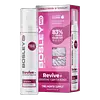What's inside
What's inside
 Key Ingredients
Key Ingredients

 Benefits
Benefits

 Concerns
Concerns

No concerns
 Ingredients Side-by-side
Ingredients Side-by-side

Water
Skin ConditioningPentylene Glycol
Skin ConditioningCaprylyl/Capryl Glucoside
CleansingButylene Glycol
HumectantLactobacillus/Soymilk Ferment Filtrate
Skin ConditioningHydroxyacetophenone
AntioxidantDiisopropyl Adipate
EmollientAllantoin
Skin ConditioningMenthyl Lactate
MaskingAcrylates/C10-30 Alkyl Acrylate Crosspolymer
Emulsion StabilisingCarnosine
Skin ConditioningAcetyl Tetrapeptide-3
Skin ProtectingTrifolium Pratense Flower Extract
AstringentPanthenol
Skin ConditioningAdenosine
Skin ConditioningTriethyl Citrate
MaskingSodium Hydroxide
BufferingCentella Asiatica Extract
CleansingGlycerin
HumectantPortulaca Oleracea Extract
Skin ConditioningPhenoxyethanol
PreservativeSodium Benzoate
MaskingBeta-Glucan
Skin ConditioningCaprylyl Glycol
Emollient1,2-Hexanediol
Skin ConditioningDextran
Water, Pentylene Glycol, Caprylyl/Capryl Glucoside, Butylene Glycol, Lactobacillus/Soymilk Ferment Filtrate, Hydroxyacetophenone, Diisopropyl Adipate, Allantoin, Menthyl Lactate, Acrylates/C10-30 Alkyl Acrylate Crosspolymer, Carnosine, Acetyl Tetrapeptide-3, Trifolium Pratense Flower Extract, Panthenol, Adenosine, Triethyl Citrate, Sodium Hydroxide, Centella Asiatica Extract, Glycerin, Portulaca Oleracea Extract, Phenoxyethanol, Sodium Benzoate, Beta-Glucan, Caprylyl Glycol, 1,2-Hexanediol, Dextran
Water
Skin ConditioningIsobutane
Trimethoxycaprylylsilane
SmoothingOleth-100
Cetyl Alcohol
EmollientCetearyl Alcohol
EmollientTerminalia Chebula Extract
AstringentBiotin
AntiseborrhoeicAsparagus Racemosus Root Powder
Skin ConditioningSodium Hyaluronate
HumectantFolic Acid
Skin ConditioningSorbitan Fatty Acid Ester
EmulsifyingDecyl Glucoside
CleansingPvm/Ma Decadiene Crosspolymer
Myristyl Alcohol
EmollientStearyl Alcohol
EmollientEthylhexylglycerin
Skin ConditioningGlycerin
HumectantSodium Hydroxide
BufferingLeuconostoc/Radish Root Ferment Filtrate
AntimicrobialPhenoxyethanol
PreservativeWater, Isobutane, Trimethoxycaprylylsilane, Oleth-100, Cetyl Alcohol, Cetearyl Alcohol, Terminalia Chebula Extract, Biotin, Asparagus Racemosus Root Powder, Sodium Hyaluronate, Folic Acid, Sorbitan Fatty Acid Ester, Decyl Glucoside, Pvm/Ma Decadiene Crosspolymer, Myristyl Alcohol, Stearyl Alcohol, Ethylhexylglycerin, Glycerin, Sodium Hydroxide, Leuconostoc/Radish Root Ferment Filtrate, Phenoxyethanol
Alternatives
Ingredients Explained
These ingredients are found in both products.
Ingredients higher up in an ingredient list are typically present in a larger amount.
Glycerin is already naturally found in your skin. It helps moisturize and protect your skin.
A study from 2016 found glycerin to be more effective as a humectant than AHAs and hyaluronic acid.
As a humectant, it helps the skin stay hydrated by pulling moisture to your skin. The low molecular weight of glycerin allows it to pull moisture into the deeper layers of your skin.
Hydrated skin improves your skin barrier; Your skin barrier helps protect against irritants and bacteria.
Glycerin has also been found to have antimicrobial and antiviral properties. Due to these properties, glycerin is often used in wound and burn treatments.
In cosmetics, glycerin is usually derived from plants such as soybean or palm. However, it can also be sourced from animals, such as tallow or animal fat.
This ingredient is organic, colorless, odorless, and non-toxic.
Glycerin is the name for this ingredient in American English. British English uses Glycerol/Glycerine.
Learn more about GlycerinPhenoxyethanol is a preservative that has germicide, antimicrobial, and aromatic properties. Studies show that phenoxyethanol can prevent microbial growth. By itself, it has a scent that is similar to that of a rose.
It's often used in formulations along with Caprylyl Glycol to preserve the shelf life of products.
Sodium Hydroxide is also known as lye or caustic soda. It is used to adjust the pH of products; many ingredients require a specific pH to be effective.
In small amounts, sodium hydroxide is considered safe to use. However, large amounts may cause chemical burns due to its high alkaline.
Your skin has a natural pH and acid mantle. This acid mantle helps prevent harmful bacteria from breaking through. The acid mantle also helps keep your skin hydrated.
"Alkaline" refers to a high pH level. A low pH level would be considered acidic.
Learn more about Sodium HydroxideWater. It's the most common cosmetic ingredient of all. You'll usually see it at the top of ingredient lists, meaning that it makes up the largest part of the product.
So why is it so popular? Water most often acts as a solvent - this means that it helps dissolve other ingredients into the formulation.
You'll also recognize water as that liquid we all need to stay alive. If you see this, drink a glass of water. Stay hydrated!
Learn more about Water